http://www.thekitchn.com/feedburnermain
Cheese! Pasta! Rotisserie chicken! And more!
READ MORE…
http://www.thekitchn.com/feedburnermain
Cheese! Pasta! Rotisserie chicken! And more!
READ MORE…
http://www.thekitchn.com/feedburnermain
Plus, pro advice for what to do instead.
READ MORE…
http://www.thekitchn.com/feedburnermain
Smashing food has become quite a trend these days. From smash burgers to smashed and fried potatoes, smashed cucumber salad or smashed fried mushrooms, people can’t get enough of it! The great news is, they are all delicious and have one thing in common, they are smashed with love and intention. We are right at the beginning of 2022 and I fully believe at this point we all deserve something a bit more elevated.
READ MORE…
http://www.thekitchn.com/feedburnermain
Act fast before they sell out again!
READ MORE…
Originally Posted At: https://breakingmuscle.com/feed/rss
On April 10, 2022, Grigsby pulled a staggering 415-kilogram deadlift (915 pounds) for two reps. He followed the sizable two-rep set and showed off his stamina by pulling a 770-pound deadlift for eight reps — a volume PR.
Check out both lifts below, courtesy of Grigsby’s Instagram profile:
[Related: Powerlifter Jessica Buettner Deadlifts 507 Pounds For 6; Crushes 405-Pound Paused Squat For 4 Reps]
Only weeks removed from notching a professional powerlifting first, these are stellar training feats for the 28-year-old Grigsby. The powerlifter had previously noted he was working through minor quad tweaks. As a result, he took the necessary precautions to avoid any further unexpected pitfalls in training.
Starting to do volume again, this is brutal
It seems Grigsby is well on his way back toward full power and endurance with these respective pulls.
Grigsby stepping up his deadlift training is an excellent sign for his prospects over the rest of the year 2022. With almost a decade’s worth of experience under his belt, he is no stranger to pushing for success as a professional powerlifter.
During the 2022 United States Powerlifting Association (USPA) Virginia Beach Classic 2, Grigsby became the first person to deadlift over 1,000 pounds in a full powerlifting meet when he pulled 465 kilograms (1,025.2 pounds). He achieved this feat while competing in the raw 125-kilogram weight class.
Here are notable results from Grigsby’s still-evolving career:
It’s one thing for an athlete to test their max strength with one great rep. It’s another task to push for a high volume with a degree of challenge.
Research has shown that pushing volume on a short-term basis with a lift can be integral to progress for a competitive athlete. However, it’s not advisable to focus on volume solely. An athlete should mix it with high-intensity, i.e., a challenging but still attainable weight.
People who managed to thread this training needle appropriately in their training for a few weeks saw noticeable upticks in hypertrophy (or muscle growth). (1)
Deadlifting for volume places considerable stress on the lower body, too. The workout is a great activator of an athlete’s hamstrings and gluteus maximus muscles (or butt), but those aren’t its primary benefactors. Partly due to the nature of the pull and eventual rep lockout, the deadlift primarily centers on activating an athlete’s quads and erector spinae (or back muscles). (2)
If a powerlifter such as Grigsby can pull a deadlift for both power and volume, then it would appear he’s performing at or near top level again.
Grigsby has not yet announced when he’ll compete in another powerlifting meet. Whenever that does happen, he has said his next major goal is to lift a 1,043.3-kilogram (2,300-pound) total between the squat, bench press, and deadlift. That total would make Grigsby second all-time behind a 1,053-kilogram (2,321.5-pound) world record set by Zac Meyers at the 2020 USPA No Luck Needed Open.
One potential upcoming option for an event is the 2022 WRPF American Pro, which will take place on July 29-30, 2022, in Manassas, VA. Grigsby competed in a WRPF event (his first-ever) as recently as September 2021 and could look to do so again.
If his recent deadlift training is any indication, Grigsby may continue to reach his ambitious goals regardless of wherever he competes next.
Featured image: @dan_grigs on Instagram
The post Powerlifter Danny Grigsby Deadlifts 915 Pounds for 2 Reps and Then Pulls 770 Pounds for 8 Reps appeared first on Breaking Muscle.
Originally Posted At: https://breakingmuscle.com/feed/rss
Ask 100 people in the gym what their goal is, and it’s a safe bet you’ll hear “I wanna get bigger” more often than not. There’s certainly nothing wrong with wanting to transform from the proverbial weakling into a larger, stronger, more confident version of yourself. Or just build some jacked arms. That’s good, too. Or maybe you want a confidence boost and to improve your health. Whatever your goal, we’re here for it.
The right approach to training, combined with plenty of goal-focused eating and long-term dedication, can deliver drastic and sometimes unbelievable results. Here’s everything you need to know about building muscle.
Fundamentally, building muscle comes down to stimulating and supporting “muscle protein synthesis” with specific training and nutrition practices. (1) Muscle protein synthesis (MPS) essentially means the physiological process responsible for creating new muscle tissue.
Unfortunately, it isn’t as simple as “lift weights, eat food, sleep, and grow.” While that summary does get the very rough idea across, several vital details will make or break your results.
You’re on the right track if you interpret “lift weights” to mean the more wordy-but-accurate “utilize resistance training to trigger a hypertrophy response”. You don’t need to lift “weights”, as in barbells or dumbbells.
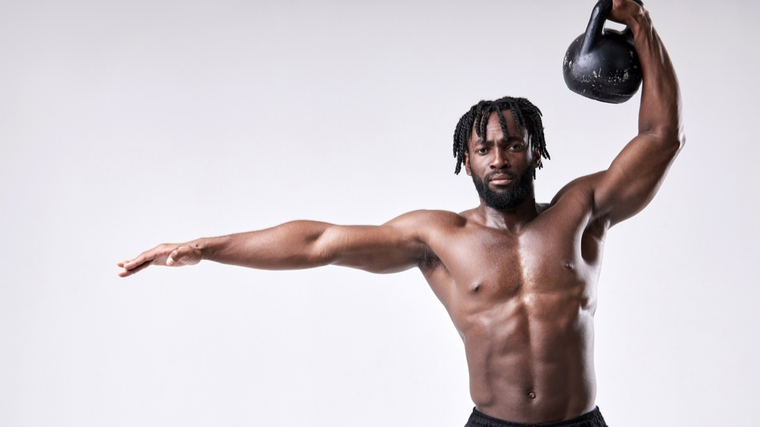
You can apply resistance with kettlebells, resistance bands, bodyweight exercises, or oddly shaped rocks. The implement itself doesn’t matter. What you do with it — the sets, reps, training intensity, and actual exercises — will determine how much muscle growth you trigger.
Eating food to build muscle is, for many people, the fun part of adding size. It’s certainly more enjoyable to eat a hearty breakfast of steak and eggs than performing grueling high-intensity set after set in the gym.
However, over-focusing on higher calories without enough attention to the specific foods, or at least the particular macronutrients (protein, carbohydrates, and fats), will make you “bigger” without necessarily becoming “more muscular” because body fat and lean muscle tissue are two very different things.
The third leg of the growth table is sleep or, more generally, recovery. Training and recovery are two sides of the same coin. You can only recover after you’ve trained, and you can’t correctly train if you haven’t recovered.
Recovery is the least glamorous aspect of building muscle because it’s the most passive. You sleep. You spend time in the kitchen, but it’s to cook food for future meals, not to eat immediately. You don’t go to the gym. If you do go, it’s to perform low-intensity exercises like… stretching.
These types of “have to, but don’t want to” activities are what separates goal-reachers from goal-wishers. Just like you wouldn’t skip a training session or a meal and expect good results, you can’t miss a chance to recover.
Here’s a more detailed breakdown of each step on the path to more muscle.
Wanting to build muscle without exercising is like expecting groceries to just show up in your refrigerator without leaving to go to the store (or at least ordering Amazon Fresh). Despite what you might see in advertisements trying to sell you an alternative, it’s an essential step you cannot avoid.
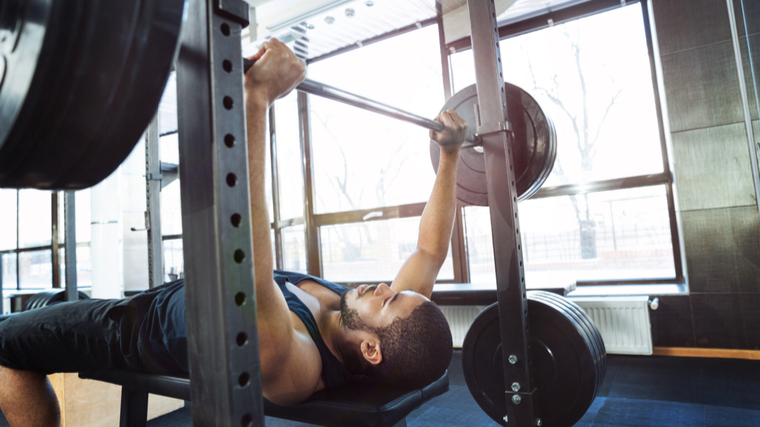
Fortunately, there are plenty of different types of workouts and training methods that can all deliver outstanding results. Just because you want to add muscle and build your body doesn’t mean you have to train “like a bodybuilder” with stereotypical two-hour workouts six days a week.
Knowing your training split, or which body parts will be trained in each workout, is one of the first steps in designing a program. But before you can even get that far, you first need to know how many total workouts you will perform each week. That will determine the weekly framework for your entire plan.
Whenever you’re training for muscle growth (and, with few exceptions, training in general), more training doesn’t necessarily equate to more results. If you stick with three or four weight training workouts per week, you’re generally in a great place to get results — especially when you’re first starting.
Training only two days per week can yield some results, but not for the type of long-term approach needed to pack on quality size. Training five days per week is relatively common, with many lifters hitting the gym before or after their workday, but it’s not necessary.
Three or four workouts per week allow optimal recovery and can be structured to accommodate a number of training splits. There are three fundamental training splits that fit very effectively into a three or four-day training week.
Full body training, where all, or nearly all, muscle groups are trained in each workout; upper/lower split training, with workouts alternating focus on either the quads, hamstrings, and calves or the back, chest, shoulders, and arms; and a push/pull/legs split, training upper body “pushing muscles” like the chest, shoulders, and triceps in one workout, upper body “pulling muscles” like the back and biceps in the next workout; and the quads, hamstrings, and calves in a third workout.
These three options provide an efficient and effective structure to provide each muscle with enough weekly training and recovery for muscle growth. Training with a body part-specific split, sometimes referred to as a “bro split,” is a popular but less efficient option, specifically for a new lifter.
Some people point out that competitive bodybuilders commonly use this approach, whose sole goal is to maximize muscle growth. True. But if you’re not eating like a competitive bodybuilder and not recovering like a competitive bodybuilder, you shouldn’t be training as a competitive bodybuilder.
Training frequency refers to how often an individual muscle group is directly trained each week. Just because you’re in the gym three or four days per week doesn’t mean each muscle is necessarily being trained three or four days per week. The cliche of lifters never finding time to train their legs reinforces that theory.
Training frequency isn’t a significant factor in determining results as long as a muscle is being directly trained at least once per week with proper intensity and the total weekly volume (sets and reps) is sufficient. (2) However, training with a higher frequency can be beneficial under several conditions.
First, higher frequency requires fewer sets per workout and is more time-efficient. A lifter could spend a 25-minute workout performing 12 sets for biceps on Sunday, for example. Or they could spend about six minutes per workout performing four sets on Monday, four sets on Wednesday, and four sets on Friday. You’ll get the same results, either way.
An increased training frequency also allows more body parts to be trained per workout, which falls directly in line with following any of the three suggested training splits. With each session requiring less work per body part and more body parts per session, higher frequency training gets more done in less time.
Every exercise falls into one of two categories: compound (multi-joint) exercises or isolation (single-joint) exercises. As the names state, compound exercises involve more than one joint in the body being recruited to move the weight. Isolation exercises restrict movement to one joint and primarily target a single muscle.
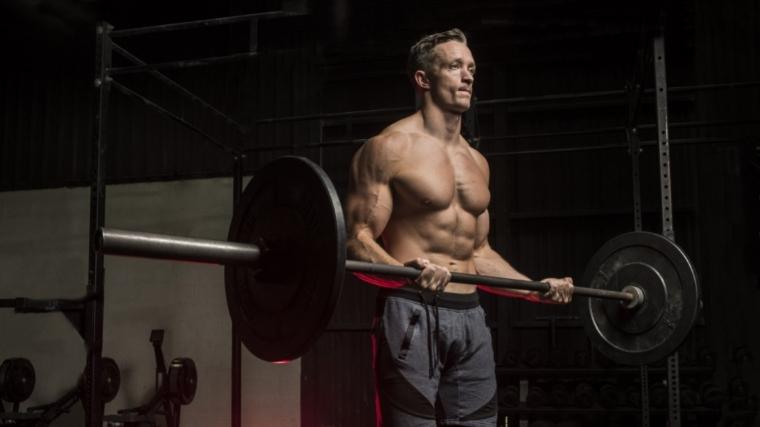
Because more joints are involved in compound exercises, more overall muscles are activated. Examples would be the bench press moving at the shoulders and elbows, the squat moving at the hips and knees, and the pull-up moving at the shoulders and elbows. This is why compound exercises are often used when the goal is to move heavy weights and display sheer strength.
Some training programs focus exclusively on using compound exercises to work larger body parts (like the back, chest, and legs) without giving any direct attention to smaller muscles like the arms and calves, but those types of programs are relatively short-term and the lack of direct attention eventually becomes a hindrance to development.
On the opposite end of the spectrum, isolation exercises move the body at just one joint to perform an exercise. Chest flyes have movement at the shoulder, leg curls at the knee, and barbell curls at the elbow.
Any training program focused primarily on isolation exercises will be extremely inefficient due to an overwhelming number of exercises needed to sufficiently work each separate body part.
It’s also important to note that when a lifter uses incorrect form to “cheat” during an isolation exercise, more joints (and more muscle groups) are recruited to complete the exercise which reduces tension on the target muscle.
To build maximum muscle size, you need to directly train all muscle groups — back, chest, shoulders, triceps, biceps, quadriceps, hamstrings, and calves. A balanced approach incorporating both compound and isolation exercises will deliver the best results.
In any given workout, targeting a body part with one to three exercises should be sufficient to stimulate growth, depending on the size of the body part (biceps require less work than quadriceps, for example) and depending on the specific training volume (sets and reps) and intensity used in the exercises.
How much are you doing, and how hard are you working? That’s the nitty-gritty of the workout itself. Training volume addresses the sets and reps performed per exercise, while training intensity covers how much muscular fatigue is achieved.
Volume and intensity have an inverse relationship. You can train with high intensity, or you can train with high volume, but you can rarely do both. Attempting that type of workout will lead to burnout and/or injury.
High-intensity training means each set is brought right to the edge of muscular failure. Your muscles cannot perform one more repetition in a full range of motion without either altering technique (cheating) or reducing the weight.
Taking sets to muscular failure is beneficial for building muscle, particularly for experienced lifters. (3) This means that you’ll need to be straining, struggling, and working hard to stimulate muscle growth at some point in each set.
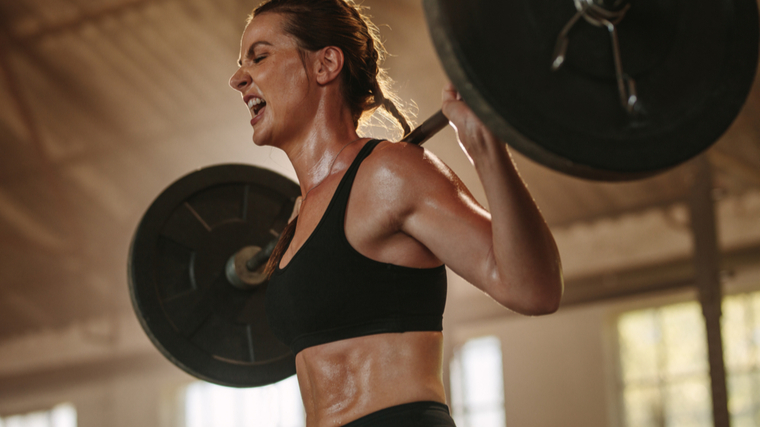
Training volume is determined by tracking the total reps and sets for an exercise and, in the bigger picture, for each body part. Performing pull-ups for three sets of five reps would be low volume. Doing 10 sets of 10 pull-ups would be considered high volume. Doing five sets of 10 barbell rows, five sets of 10 pull-ups, and five sets of cable rows would also be a higher volume back workout.
To make things slightly more confusing, it’s possible to have a high-volume workout consisting of low-volume exercises. For example, performing one set of 10 reps for 12 different exercises would be an example of this inefficient approach.
Moderate to higher training volume has been shown to deliver more muscle growth than lower volume training. (4) Aim to work larger muscle groups with roughly 15-20 sets per week and relatively smaller muscle groups with around 9-12 sets per week, with each set in the six to 15 rep range.
Break that weekly volume into per-workout numbers based on your training split and total number of training days. For example, training three days per week with a full body split, you could train your back, chest, and legs with five to six sets per workout while training shoulders and arms with three to four sets.
In order to balance volume and intensity, not every set should be taken to muscular failure. For optimal growth and recovery, only the last one or two sets of an exercise should reach the highest levels of fatigue and failure.
“Do the same you’ve always done and you’ll get the same you’ve always got.” That old maxim applies to the gym, too. Progressive overload is a core principle of any weight training plan, especially for muscle growth.
To continue seeing steady results, training should be progressed each week by increasing the challenge to the muscles and pushing yourself to do more. “More” can be achieved by one of three methods. Increased volume, increased load, or increased intensity.
Increasing volume is the simplest approach: Do one or more reps than you did last workout. Ideally these extra reps are added to the last set, meaning your body is under more total stress to reach muscular failure. This method shouldn’t be used indefinitely or you’d end up performing 35 time-wasting, low intensity reps per set.
Increasing load is likely the most common progression method. Everyone enjoys adding weight and getting stronger. However, when the goal is muscle growth, moving the heaviest weights possible isn’t necessary. Extremely heavy weights require performing low-rep sets, which means sufficient training volume isn’t achieved. You should always be able to work within the intended rep range.
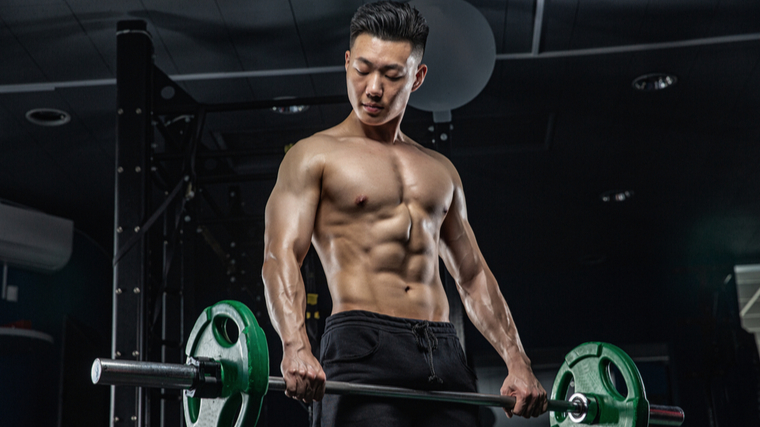
Increasing intensity each week is another overlooked but highly effective progression method. You can make each set harder with intensity-boosting techniques like slow negatives (lowering the weight at a drastically slower speed to increase muscular tension) or drop sets (quickly reducing the weight to complete additional reps). These techniques significantly increase training stress and can require additional recovery time.
Any of the progression methods can be equally effective as long as the total volume and target rep ranges are maintained. Incorporating a combination of added reps and more weight is a time-tested approach to building muscle.
Increase reps until you reach the top end of the target rep range, and then add weight so you’re only able to perform the lowest reps in that range. Again, add reps weekly and repeat the process. For example, begin with 135 pounds for 10 reps. Add one rep each week until you’re performing 14-15 reps. From there, add five to 10 pounds, which should bring you back to performing around 10 reps and begin adding reps again, now with the heavier weight.
Nutrition is one aspect of muscle-building that many lifters underappreciate. The right nutrition plan can mean the difference between gaining inches around your waistline or inches around your chest.
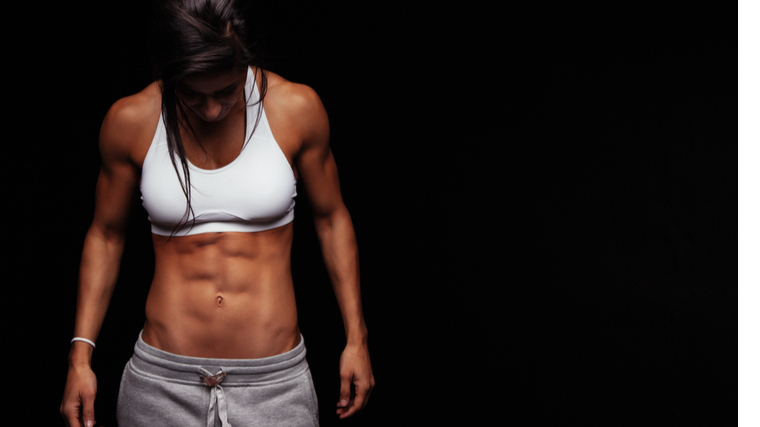
Hard-training lifters require plenty of fuel to get through intense workouts, as well as restorative nutrition to kickstart recovery after the training has triggered muscle growth. Without paying attention to your diet, building muscle becomes, literally, impossible.
Your body needs the right nutrition to support growth. Here’s how to setup a muscle-building diet.
Most lifters love the idea of eating to gain size. “Bulking season” is treated like a long-term holiday where calories can be piled in free and clear because “they’re gonna be turned to muscle.” The only problem is, there’s a line between eating for size and eating like a glutton — and it’s not as fine as you think.
Muscle growth can be sufficiently supported by taking in an extra 350 to 500 calories per day. (5) That’s a far cry from the free-for-all some “permabulkers” mistakenly believe is needed to add size.
Potentially more important for muscle growth, however, is the macronutrient breakdown of those extra calories — the protein, carbohydrates, and dietary fats in the diet.
Protein is the single most important nutrient when it comes to building muscle. Protein is the only source of amino acids, which are the structural building blocks of muscle tissue. That’s why muscle protein synthesis is critical for growth. You’re creating new muscle tissue. Eat all the carbs and fats you like, but without a proper supply of protein, there will be no new muscle.
Daily protein intake doesn’t need to be complicated. A rough guideline of one gram of protein per pound of bodyweight is a reliable rule of thumb. Research has actually shown as little as 0.74 grams of protein per pound of bodyweight to be most effective. (6) If you don’t mind the bit of added math, go for it. Rounding up to a gram won’t have any negative effects.
One important aspect of protein is the source. While animal-based proteins typically have a higher bioavailability and improved absorption rates making them highly efficient, vegetarian protein alternatives have been shown to be comparably effective when the rest of the diet’s nutrients and calories are well-planned. (7)
Carbs are a hot topic in fat loss discussions, but their role in building muscle isn’t often discussed. Think of carbs as fuel — they’ve been shown to support performance during intense training, particularly higher volume workouts. (8)
Triggering muscle growth by performing those intense workouts, and then supporting that growth with an ample diet, should deliver significant results. The key issue with carbs is how easily they can sneak into the diet and push the daily calories far above the intended level.
Focusing on whole-food sources of carbs such as fruits, root vegetables, legumes, and minimally processed grains should allow you to take in sufficient energy without a drastic excess of calories.
Dietary fats have gone from public outcast to hero and back again. While fats don’t play a direct role in building muscle, they support overall health and hormone function. (9)
Fats are much more calorie-dense than either protein or carbs, making them even more likely to push daily calories into excess unless closely monitored. Minimally processed oils, natural animal fats, and certain fruits (particularly avocado and coconut) should be the primary fat sources in a muscle-building diet.
No matter how hard a workout is, you never actually build muscle in the gym. Your body only builds muscle once you’ve gotten home, eaten some good food, and started to rest. While grabbing a post workout shake from the gym’s smoothie bar can be a good start, it’s not enough. (10)
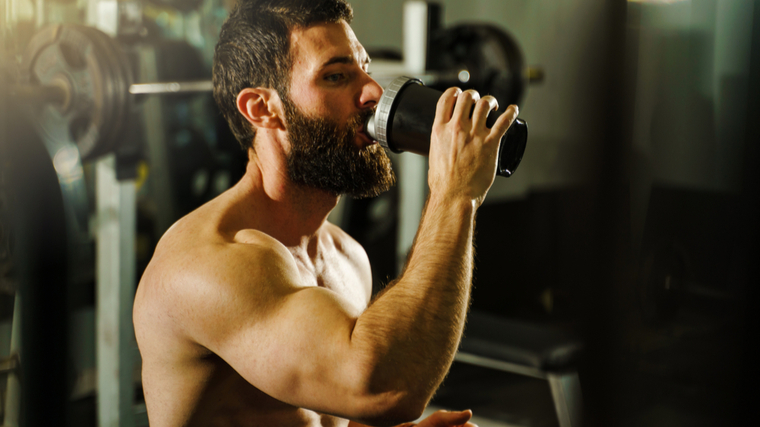
Overtraining is a genuine condition which can result from too much work and insufficient recovery. This, over time, leads to a lack of results and potential injury from overuse and fatigue. Fortunately, a few simple recovery methods can help to ensure major results.
Some lifters feel the gym is their escape from the stresses of everyday life and a day without training is unimaginable. While there’s plenty of validity to the therapeutic benefits of exercise, weight training requires a different approach. Lifting weights, essentially, breaks the body down and can’t be repeated daily unless very specific program considerations are in place.
A basic training week will include three to four training days and three to four non-training (rest) days. While total rest is the most straightforward way to ensure recovery, “active recovery” is an alternative for the lifter who just can’t sit still.
Active recovery involves lower intensity training, often cardiovascular exercise like walking, running, or biking; sports practice like basketball, tennis, or martial arts; or mobility training like yoga or similar stretching routines.
These types of active, but not brutally intense, sessions have been shown to benefit lifters both physiologically and psychologically. So it’s good for your body and your brain. (11) If a day of not training is truly unbearable, you can support your recovery by taking an easier training day.
You sleep every night (hopefully), but if you’re getting less than seven hours, you could be hindering your recovery. Certainly some people have adapted to operating with less sleep, but research has shown seven to nine hours to be ideal for supporting athletic performance. (12) Insufficient sleep has also been shown to negatively affect hormone production, muscle mass, and strength. (13)
Sure, it’s easy to just suggest “sleep more” while the reality may involve important variables like family life and work commitments. The important takeaway is to pay specific attention to your sleeping patterns when building muscle is the goal. Any steps to improve your sleep will be worth the effort.
You’ve learned how to build muscle, what works and what doesn’t, and why. Here’s a quick grab and go plan to get started (which, to be honest, most people probably jumped right to). The exercise listings are placeholders. Plug in any exercises that work the target body part.
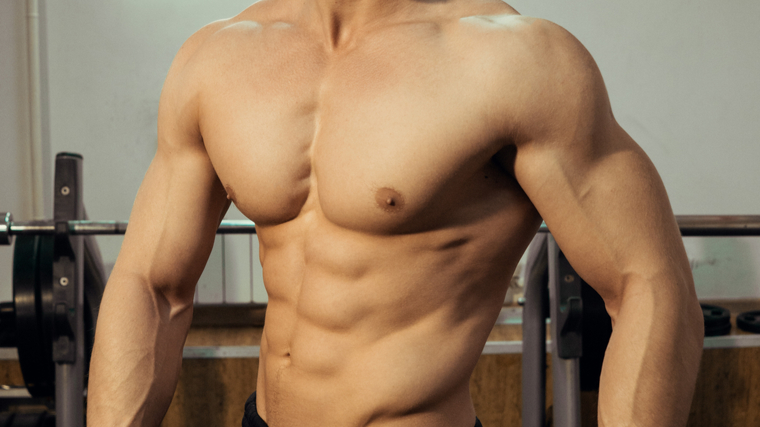
Rest. No training. Cook a few good meals to have leftovers for the week.
Upper Body Workout
Lower Body Workout
Cardiovascular exercise (walk, run, bike), 30 minutes.
Upper Body Workout
Lower Body Workout
Stretching or mobility exercise, 30 minutes.
If you’re one of those “I wanna get bigger” lifters in the gym, you’ve now got all the info you need to set up an effective plan, in the gym and outside of it, to support your gains. Get your training, nutrition, and recovery lined up, and go pack on some size.
Featured Image: Lebedev Roman Olegovich / Shutterstock
The post How to Build Muscle: The Training and Diet Guide for Beginners and Advanced Lifters appeared first on Breaking Muscle.
http://www.marksdailyapple.com/
 These macadamia nut cookie bars are our take on a classic blondie recipe. Blondies have more fun, right?
These macadamia nut cookie bars are our take on a classic blondie recipe. Blondies have more fun, right?
Blondie bars are similar to brownies, but instead of cocoa they feature vanilla and, usually, brown sugar. We wanted ours to be a Primal, paleo, and keto-friendly dessert recipe, so these bars get their signature flavor from monk fruit sweetener and something cool and unexpected: macadamia nut butter!
Macadamia nuts are a good source of monounsaturated fats, and a quarter-cup of macadamias provides 77 percent of your daily manganese requirement and 28 percent of your copper. And don’t even get us started on their creamy texture, which makes these blondie cookie bars all the more decadent.
Makes: 9 bars
Time in the kitchen: 10 – 15 minutes prep time + 25 minutes to bake
Matcha Latte:
1 cup milk of choice
2 scoops Primal Kitchen Matcha Collagen Keto Latte

Preheat your oven to 350 degrees Fahrenheit (175 degrees Celsius). Grease a small square baking dish (ours was 7-inch x 7-inch).
In a bowl, mix together the macadamia nut butter, coconut oil, vanilla extract, and milk. Add the almond flour, granulated sweetener, ground chia seeds, coconut flour, and salt. Combine until a crumbly mixture forms. Add the liquid sweetener to taste.
Whisk the eggs and add them to the bowl. Mix until a thick batter forms.

Fold in the chocolate chips and macadamia nuts. If the nuts are large, you can roughly chop them before adding them to the mixture.
Pour the batter into the greased baking dish and spread using a spatula so it is uniform in thickness. Top with additional chocolate and nuts if desired.

Bake for 25 to 28 minutes, or until the edges are slightly golden. Allow the bars to cool before cutting into 9 bars.
Serve with a matcha latte! To make, warm your milk in a small saucepan. Add the Primal Kitchen Matcha Collagen Keto Latte mix and whisk to combine or use a frothing wand.

Calories: 318
Fat: 28 g
Total Carbs: 20 g
Net Carbs: 8 g
Protein: 8 g

This take on a paleo and keto-friendly blondie bar recipe is sweetened with monk fruit features macadamia nut butter.
1/4 cup Brad’s Macadamia Masterpiece nut butter
3 Tbsp. softened coconut oil
1/2 Tbsp. vanilla extract
1 tsp. milk of choice
1 cup + 2 Tbsp. almond flour
1/3 cup granulated monk fruit sweetener
1 1/2 Tbsp. ground chia seeds
3/4 tsp. coconut flour
1/4 tsp. salt
About 4 drops liquid monk fruit or stevia
2 eggs
1/2 cup keto-friendly dark chocolate chips or chocolate chunks
1/3 cup macadamia nuts
Matcha Latte:
1 cup milk of choice
2 scoops Primal Kitchen Matcha Collagen Keto Latte
Preheat your oven to 350 degrees Fahrenheit (175 degrees Celsius). Grease a small square baking dish (ours was 7-inch x 7-inch).
In a bowl, mix together the macadamia nut butter, coconut oil, vanilla extract, and milk. Add the almond flour, granulated sweetener, ground chia seeds, coconut flour, and salt. Combine until a crumbly mixture forms. Add the liquid sweetener to taste.
Whisk the eggs and add them to the bowl. Mix until a thick batter forms.
Fold in the chocolate chips and macadamia nuts. If the nuts are large, you can roughly chop them before adding them to the mixture.
Pour the batter into the greased baking dish and spread using a spatula so it is uniform in thickness. Top with additional chocolate and nuts if desired.
Bake for 25-28 minutes, or until the edges are slightly golden. Allow the bars to cool before cutting into 9 bars.
Serve with a matcha latte! To make, warm your milk in a small saucepan. Add the Primal Kitchen Matcha Collagen Keto Latte and whisk to combine or use a frothing wand.
These bars are even better once they are refrigerated. For a gooier, softer bar, bake for slightly less time.
You can add more or fewer drops of liquid sweetener depending on how sweet you’d like the bars to be.
Feel free to use your favorite chocolate chips or chopped-up chocolate bar. We used keto-friendly chocolate chips, but 85 or 90 percent dark chocolate works well too.
This recipe has only been tested with Brad’s Macadamia Masterpiece, but in lieu of it, you could try using half nut butter and half coconut butter. The consistency of the bar may differ slightly.
We used refined coconut oil, but you can also use virgin coconut oil if you’d prefer a stronger coconut flavor.
Keywords: Macadamia cookie bars, Blondie bars, Keto desserts, Paleo desserts
The post Macadamia Nut Cookie Bars (Keto and Paleo!) appeared first on Mark’s Daily Apple.
Originally Posted At: https://breakingmuscle.com/feed/rss
Jessica Buettner certainly knows how to leave an impression in the gym. On April 7, 2022, the powerlifter made her presence felt again when she crushed a 212.5-kilogram squat (469 pounds). Buettner followed that staggering lift with a 230-kilogram deadlift (507 pounds) for six reps, and a 183.7-kilogram paused squat (405 pounds) for four reps.
Check out Buettner’s lifts below, courtesy of her Instagram profile:
[Related: Powerlifter Jessica Buettner (76KG) Deadlifts 252.5 Kilograms In Training For New PR]
According to Buettner, her traditional squat in training was a mere five kilograms (11 pounds) off her PR. Notably, while unofficial, it also eclipses her all-time competition best of 210.4 kilograms (464 pounds). Meanwhile, the six-rep deadlift is only 17.5 kilograms (38.5 pounds) away from the current International Powerlifting Federation (IPF) world record — which belongs to Buettner.
The last time Buettner lost in a powerlifting competition was the year 2019. Here are some of the notable results of the Canadian-born athlete’s career:
A traditional squat with a loaded barbell is challenging enough for any athlete. The pause offers another distinctive element.
An athlete will usually come to a complete stop at the bottom of their squat rep in a paused squat. That’s in contrast to the traditional squat, where an athlete hits at least the 90-degree parallel and immediately drives back up. Note: Some people might elect to pause halfway between the top and the parallel, but a pause at the bottom is more common.
While in the hole (or the lowest position of the squat), the athlete will hold that position for at least a couple of seconds. The timing can vary, often depending on personal preference and training regimen. Finally, they’ll explode up to lock out the rep. The pause does not necessarily change the tempo of the overall squat rep itself. An athlete can elect to go down slower, too.
One of the more notable benefits of the pause is that a powerlifter puts their legs under increased tension, leading to improved strength and hypertrophy (or muscle growth). The more an athlete places their muscles in isometric contraction (or keeping their muscles in a stable contracted position), the more gains they might see. One recent study found that women who performed pauses squats instead of the traditional variation saw greater hypertrophy. (1)
The paused squat will ask more of an athlete’s quad muscles and knees, too.
Like the traditional variation, the paused squat still works the glutes, hamstrings, calves, and overall core, but demands more of the quads because of the extended time in the hole. That slower movement will give an athlete larger and stronger quads. (2) Plus, because the pause keeps an athlete’s knees flexed for longer while bearing their squat weight, it might also improve their knee extension strength.
By training with a paused squat, Buettner is potentially increasing her squat capacity and improving her overall leg strength simultaneously.
In what appears to be a confirmation in her Instagram post, Buettner says she will compete in the 2022 IPF World Classic Powerlifting Championships. We’ll see if she can continue her recent hot streak there.
The event will be on June 6-12, 2022, in Sun City, South Africa.
Featured image: @djessicabuettner on Instagram
The post Powerlifter Jessica Buettner Deadlifts 507 Pounds for 6; Crushes 405-Pound Paused Squat for 4 Reps appeared first on Breaking Muscle.
Originally Posted At: https://breakingmuscle.com/feed/rss
Roughly four years ago, at the age of 34, Tamara Walcott began competitive powerlifting. Ever since, as one of the sport’s rising names, she’s more than made up for any perceived lost time. On April 7, 2022, ahead of the 2022 World Raw Powerlifting Federation (WRPF) American Pro, Walcott shared some of her recent training progress when she locked out a 151.95-kilogram (335 pounds) bench press for two reps.
Check out the lift below via Walcott’s Instagram profile:
[Related: Powerlifter Amanda Lawrence Wins Best Overall Lifter At 2022 AMP Classic Open Nationals]
Walcott’s journey to powerlifting success is notable because of the adversity she’s overcome. On top of crushing deadlifts and squats professionally, she’s a single mother with two kids, working a full-time job, and a business owner. Any person might have trouble juggling so much on their plate, but, thus far, it doesn’t appear to have been an issue for Walcott.
As a prominent powerlifter with a platform, Walcott knows she can’t let up. She appears to be more than happy to wear this honor with pride.
“Just like the video said, I ain’t never giving up,” Walcott wrote in the post’s caption. “Why? Because I do this for me. The bonus in the process is what I do inspires others! I’m humbled by that, but that can’t be our driving force. We have to be our driving force.”
Indeed, Walcott is not short on situations where she’s been a quality powerlifting role model. In eight career competitions, she has seven victories. In one of her more recent wins at the 2021 WRPF The Bucked Up Showdown, she pulled a current world deadlift of 288.5 kilograms (606 pounds).
Always make sure you take care of you first
Still, her success doesn’t mean she can always go full steam ahead. Walcott appears to understand that attaining powerlifting glory is a gradual process — which explains why she says she took a recent approximate week’s break from training. To Walcott, every small victory, at a good pace, holds merit in a long and fulfilling journey.
“I always listen to my body,” Walcott continued. “I’m back for now, and I’m coming with a vengeance. There is work to be done. There are records to break. So preparation and proactiveness are key! I’m a beast; therefore, maintenance routinely is essential.”
[Related: Powerlifter Tiffany Chapon Exceeds Total & Squat World Records While Training]
Walcott doesn’t seem to show any desire to squander her current opportunity. In recent interviews, she hasn’t been shy in passionately discussing how her foray into powerlifting remade her self-image.
More importantly, while taking care of her personal life, Walcott says she now possesses revitalizing energy that she wants to transfer to others. Her March 2022 spot on Access Hollywood saw her dive into more detail on the past and this ongoing honorable mission for visibility:
“I’m at a crossroad, I can’t keep doing this, I have to live for my kids,” Walcott said of her mindset during her low point. “I have to be here for them. I have to change my life. So, I decided to go back to the gym and lose some weight.”
It’s the next step that might have changed not only Walcott’s life trajectory but perhaps the future of powerlifting. While working out one day, she saw a few athletes clanging weights and “throwing chalk around.” The rest was history.
“I asked about it, and they were like, ‘Oh yeah, they’re powerlifters, that’s what they’re doing,’” Walcott said. “And I was like, I want a piece of that.”
As for whether Walcott would endorse powerlifting to other women, her answer could not have been more resounding.
“I would recommend it [powerlifting] to more women, especially since I have a 15-year-old daughter,” Walcott said. “It translates to so many aspects of your life. It keeps you dedicated, motivated. You’re able to go in the gym and do things you thought you couldn’t do. Not only has it changed me physically, it’s changed me mentally. It’s made me mentally strong.”
As she continues to expand her reach, Walcott is hosting an upcoming open forum about tackling stereotypes on April 24, 2022, in New York City. Tickets for the event can be purchased on her website. Walcott’s next competition — the 2022 WRPF American Pro — will take place on July 29-30, 2022, in Manassas, VA.
Featured image: @plussize_fitqueen4.0. on Instagram
The post Tamara Walcott Notches 151.95-Kilogram Bench Press (335 Pounds) for 2 Reps, appeared first on Breaking Muscle.
http://www.marksdailyapple.com/

Research of the Week
MCT oil helps seniors with Alzheimer’s disease.
Chocolate also helps seniors with memory.
The smell of putrescine (smell of death) may confer greater life satisfaction (makes you love life) on those smelling it.
Oxidized linoleic acid promotes colorectal cancer.
Wearing many common types of face masks causes you to breathe in microplastics.
Frame healthy eating as rebellion to get teens off junk. Could it work?
The carpet cleaner who speaks 24 languages.
A panel on linoleic acid and obesity.
An easy way to consume liver.
Man live tweeting his participation in a dysentery vaccine challenge study.
“Pfizer and me — Best buddies”
Interesting: Sleeping more causes overweight adults to eat less.
I’m not surprised: Everyone in the world seems to enjoy the smell of vanilla.
Fascinating study: “What would you do if you were me, doctor?”
What can’t it do?: Keto helps with binge eating.
Interesting video: Peter Thiel on Bitcoin.
What should you be doing but aren’t?
One year ago (Apr 2 – Apr 8)
“I had lion meat once at a fancy wild game dinner event. It is… not good…. It had the texture and color of a pork chop, but the flavor was just… weird. I can’t imagine anyone buying lab grown lion more than once, and if it’s the first lab grown meat they ever try, they might blame the process and not the “animal,” and never buy lab grown meat again. You decide if that’s a good thing or a bad thing.”
-Lion meat sounds terrible.
The post New and Noteworthy: What I Read This Week—Edition 172 appeared first on Mark’s Daily Apple.